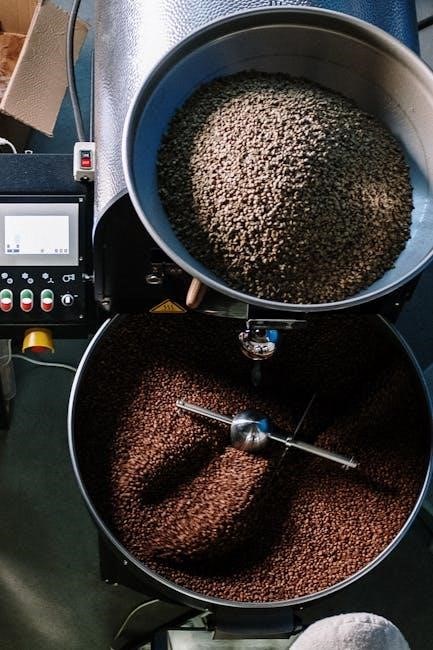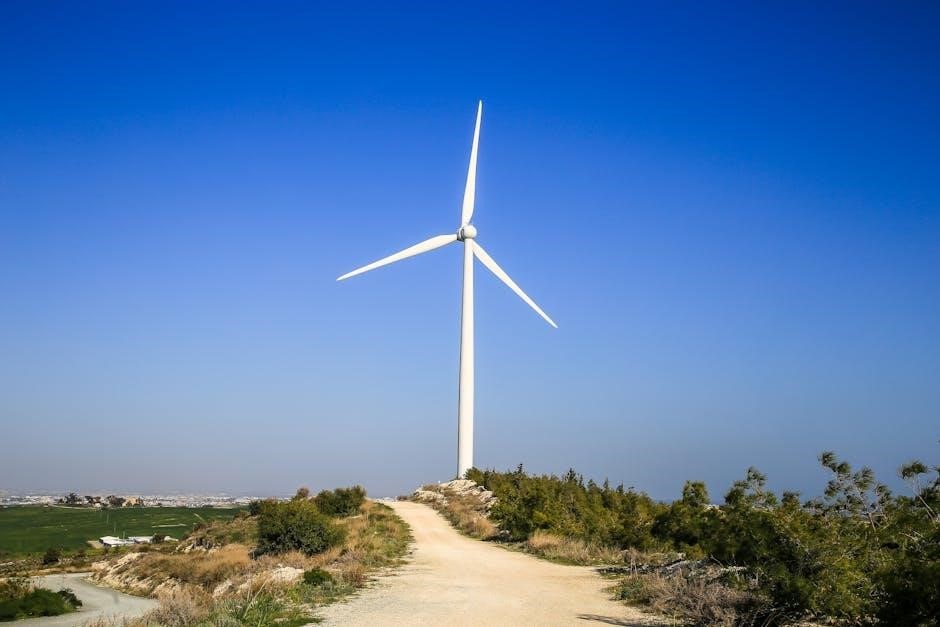Green production focuses on sustainable manufacturing practices that minimize environmental impact while maintaining economic efficiency. It emphasizes reducing carbon footprints, conserving resources, and promoting eco-friendly processes to foster a healthier planet.
1.1 Definition and Importance of Green Production
Green production refers to manufacturing processes that prioritize environmental sustainability, aiming to reduce waste, emissions, and resource consumption. It integrates eco-friendly practices to minimize ecological impact while ensuring economic viability. The importance lies in its ability to address climate change, promote resource efficiency, and foster innovation. By adopting green production, businesses can meet growing consumer demand for sustainable goods, enhance their reputation, and contribute to a healthier planet for future generations.
1.2 Brief History and Evolution of Sustainable Manufacturing
The concept of sustainable manufacturing emerged in the late 20th century, driven by growing environmental concerns. The 1970s and 1980s saw initial efforts to reduce industrial pollution, while the 1990s introduced life cycle assessments and eco-design principles. The 21st century accelerated adoption through technological advancements, global standards, and consumer demand. Today, sustainable manufacturing integrates renewable energy, circular economy principles, and advanced technologies, evolving into a core strategy for industries worldwide to achieve environmental and economic harmony.
1.3 Benefits of Green Production for the Environment and Businesses
Green production significantly benefits both the environment and businesses by reducing carbon emissions, conserving resources, and lowering operational costs. It enhances brand reputation, attracting eco-conscious consumers and increasing market share. Additionally, adherence to environmental regulations can reduce legal risks and penalties, while innovative sustainable practices often lead to competitive advantages. Businesses adopting green production strategies also contribute to global sustainability goals, fostering long-term environmental and economic health.

Key Principles of Green Production
Green production revolves around sustainability, efficiency, and minimal environmental impact, emphasizing renewable resources, waste reduction, and circular economy practices to achieve eco-friendly and responsible manufacturing processes.
2.1 Sustainability in Manufacturing Processes
Sustainability in manufacturing focuses on minimizing environmental impact through efficient resource use, renewable materials, and waste reduction. It integrates eco-friendly technologies and practices to ensure long-term viability while meeting consumer demands. By adopting sustainable methods, manufacturers can reduce carbon emissions, conserve water, and lower energy consumption. This approach aligns with global environmental standards and promotes a balance between economic growth, social responsibility, and ecological health, fostering a greener future for industries worldwide.
2.2 Renewable Energy Sources in Production
Renewable energy sources, such as solar, wind, and hydropower, are increasingly integrated into production processes to reduce reliance on fossil fuels. These clean energy sources minimize carbon emissions, enhance energy independence, and lower operational costs. Manufacturers are adopting solar panels and wind turbines to power factories, while hydro energy supports industrial processes in regions with abundant water resources. Transitioning to renewable energy not only aligns with environmental goals but also ensures sustainable and resilient production systems for future generations.
2.3 Waste Reduction and Management Strategies
Effective waste reduction and management are critical in green production. Implementing strategies like lean manufacturing minimizes waste generation by optimizing resource use. Recycling programs and composting initiatives convert waste into valuable materials, reducing landfill dependency. Additionally, companies adopt zero-waste policies, encouraging the reuse of by-products. Proper waste segregation and disposal methods ensure hazardous materials are handled safely. These practices not only reduce environmental impact but also contribute to cost savings and operational efficiency, fostering a sustainable production ecosystem.
2.4 Circular Economy and Its Role in Green Production
The circular economy is a cornerstone of green production, emphasizing the reuse and recycling of materials to minimize waste. By designing products for durability and recyclability, companies reduce resource consumption and environmental impact. This approach encourages closed-loop systems where materials are constantly cycled back into production. The circular economy fosters innovation, reduces costs, and promotes sustainable growth. It aligns with green production goals by creating a regenerative system that benefits both businesses and the environment, ensuring long-term sustainability.

Renewable Energy in Green Production
Renewable energy is vital for green production, reducing reliance on fossil fuels and lowering emissions. Solar, wind, and hydro energy power sustainable manufacturing, promoting eco-friendly practices and energy efficiency while supporting global climate goals. This shift ensures cleaner production processes, aligns with environmental regulations, and fosters long-term sustainability in industries worldwide.
3.1 Solar Energy Integration in Manufacturing
Solar energy integration in manufacturing is a cornerstone of green production, offering a clean and abundant power source. By installing solar panels, factories reduce reliance on non-renewable resources, lowering energy costs and carbon emissions. Solar power supports sustainable operations, aligns with global climate goals, and enhances energy independence. Industries like automotive and electronics are increasingly adopting solar solutions to meet net-zero targets, showcasing its viability in driving eco-friendly industrial transformation.
3.2 Wind Energy Applications for Sustainable Production
Wind energy is a vital component of green production, providing a clean and reliable power source for manufacturing. By harnessing wind, industries can significantly reduce carbon emissions and operational costs. Wind turbines supply electricity for factories, while excess energy can be stored or sold back to the grid. This renewable resource is particularly beneficial for energy-intensive sectors like steel and chemicals, enabling them to transition toward sustainable and eco-friendly production practices.
3.3 Hydro Energy and Its Use in Industrial Processes
Hydropower is a reliable and scalable renewable energy source for industrial applications. It provides consistent electricity for manufacturing processes, reducing reliance on fossil fuels. Hydro energy powers machinery, supports water management systems, and enables energy storage through pumped-storage hydroelectricity. Its scalability makes it suitable for both small-scale and large industrial operations, contributing to cost savings and reduced carbon emissions while promoting sustainable industrial development.
Sustainable Materials and Practices
Sustainable materials, such as recycled metals and biodegradable plastics, reduce environmental impact. Practices include minimizing waste and optimizing resource use to support green production efficiently.
4.1 Eco-Friendly Raw Materials for Production
Eco-friendly raw materials are essential for green production, reducing environmental impact. Biodegradable plastics, recycled metals, and sustainably sourced wood minimize resource depletion. Organic cotton and hemp are alternatives to synthetic fibers, lowering carbon footprints. These materials promote sustainability, conserve natural resources, and align with global environmental standards, enabling businesses to meet consumer demand for greener products while fostering a healthier planet.
4.2 Water Conservation Techniques in Manufacturing
Water conservation in manufacturing is vital for sustainability. Techniques include implementing water recycling systems, using water-efficient equipment, and optimizing production processes to minimize waste. Rainwater harvesting and reusing treated wastewater are effective strategies. Regular audits help identify inefficiencies, ensuring responsible water use. These practices reduce operational costs, enhance environmental stewardship, and align with global sustainability goals, making manufacturing processes more eco-friendly and responsible.
4.3 Sustainable Supply Chain Management
Sustainable supply chain management ensures environmentally responsible practices throughout production, from raw material sourcing to delivery. It involves collaboration with suppliers to adopt eco-friendly practices, reduce carbon footprints, and promote ethical labor standards. Implementing green logistics, such as optimizing transportation routes and using cleaner vehicles, further enhances sustainability. Technology plays a key role in tracking and improving supply chain efficiency, ensuring a greener and more resilient production process.
Reducing Emissions and Carbon Footprint
Reducing emissions and carbon footprint is critical for combating climate change. Transitioning to cleaner energy, improving energy efficiency, and adopting carbon capture technologies are key strategies to achieve this goal.
5.1 Strategies to Minimize Carbon Emissions
To minimize carbon emissions, industries can transition to renewable energy sources like solar and wind, reducing reliance on fossil fuels. Optimizing production processes to reduce energy consumption is essential. Implementing carbon capture and storage technologies can further lower emissions. Additionally, adopting energy-efficient equipment and smart manufacturing tools helps reduce energy waste. Sustainable supply chain practices and employee training on energy-saving practices also play a key role in achieving emission reduction goals.
5.2 Energy-Efficient Technologies in Production

Energy-efficient technologies are crucial for reducing energy consumption in production. LED lighting, for instance, cuts energy use by up to 70%. Variable-speed drives on motors can lower consumption by 30%. Smart sensors and automation optimize energy use by monitoring processes in real time. Additionally, energy management systems (EMS) help track and reduce waste. Investing in these technologies not only lowers operational costs but also supports environmental sustainability goals, making production cleaner and more efficient.
5.3 Reducing Greenhouse Gas Emissions in Industry
Reducing greenhouse gas emissions in industry requires a multi-faceted approach. Carbon capture and storage technologies can significantly lower emissions from industrial processes. Transitioning to renewable energy sources, like solar or wind, reduces dependence on fossil fuels. Optimizing production processes to minimize energy use also helps. Additionally, industries can adopt circular economy practices, recycling materials to reduce waste and emissions. Collaborating with governments and NGOs to implement emission-reduction strategies ensures a collective effort toward sustainability and meeting global climate goals.

Waste Management and Recycling
Effective waste management and recycling are critical for sustainable production. Implementing recycling programs reduces material waste, while proper disposal of hazardous materials ensures environmental safety.
6.1 Recycling Processes in Green Production
Recycling processes in green production involve transforming waste materials into reusable resources, reducing the need for raw material extraction. This includes sorting, processing, and repurposing materials like paper, plastic, metal, and glass. Implementing recycling programs helps conserve natural resources, lowers production costs, and decreases environmental impact. Many companies adopt closed-loop systems, where waste is continually cycled back into production, promoting sustainability and minimizing landfill use. Effective recycling also reduces greenhouse gas emissions associated with manufacturing.
6.2 Minimizing Packaging Waste
Minimizing packaging waste is crucial for reducing environmental impact. Strategies include using biodegradable or recyclable materials, optimizing package design to reduce size and weight, and adopting reusable containers. Companies can also shift to minimalist packaging, eliminating unnecessary layers or plastics. Encouraging refill programs and offering concentrates or bulk options further reduces waste. Lightweight and compostable packaging solutions are gaining popularity, aligning with consumer demand for sustainability. These practices help conserve resources, lower costs, and minimize landfill contributions.
6.3 Proper Disposal of Hazardous Materials
Proper disposal of hazardous materials is essential to prevent environmental contamination. Industries must segregate hazardous waste, such as chemicals, batteries, and e-waste, and dispose of them through licensed facilities. Incineration, landfilling, and recycling are common methods, depending on the material. Compliance with local and international regulations ensures safety. Training employees on handling and documentation further enhances responsible disposal practices, minimizing ecological risks and promoting a safer environment for future generations.

Policy and Regulations in Green Production
Governments worldwide establish policies and regulations to enforce green production standards, ensuring eco-friendly practices and compliance with environmental laws, fostering sustainable development and innovation.
7.1 Government Policies Promoting Sustainable Production
Governments worldwide implement policies to encourage sustainable production, offering incentives like tax breaks, grants, and subsidies for eco-friendly practices. Regulations enforce environmental standards, reducing emissions and waste. These policies create frameworks for businesses to adopt green technologies, promoting resource efficiency and renewable energy use. Public-private partnerships further accelerate innovation, ensuring alignment with global sustainability goals and fostering a culture of environmental responsibility across industries.
7.2 Industry Standards for Environmental Responsibility
Industry standards for environmental responsibility provide frameworks for businesses to adopt sustainable practices. Certifications like ISO 14001 and LEED set benchmarks for reducing environmental impact. These standards encourage resource efficiency, waste reduction, and renewable energy use. Compliance often enhances brand reputation, opens market opportunities, and aligns companies with global sustainability goals. Industries voluntarily adopt these standards to demonstrate commitment to eco-friendly operations and continuous improvement in environmental performance.

Incentives for Adopting Green Production
Incentives for adopting green production include tax breaks, grants, and subsidies that reduce initial costs. These encourage businesses to invest in sustainable technologies and practices.
8.1 Tax Incentives for Sustainable Manufacturing
Tax incentives play a crucial role in promoting sustainable manufacturing by reducing financial burdens on businesses. Governments offer tax credits, deductions, or exemptions for investing in eco-friendly technologies, such as renewable energy systems or energy-efficient equipment. For instance, companies adopting solar panels or reducing emissions may qualify for federal or state tax benefits. These incentives encourage businesses to prioritize sustainability while improving their bottom line, fostering a competitive advantage and supporting environmental goals.
8.2 Grants and Funding for Green Initiatives
Grants and funding opportunities are instrumental in driving green production initiatives. Governments, NGOs, and international organizations provide financial support to businesses adopting sustainable practices. These funds often target research and development, eco-friendly machinery, and renewable energy integration. Grants also encourage innovation in sustainable technologies and processes. By securing external funding, companies can offset initial costs and accelerate their transition to greener operations, enhancing their environmental impact and market competitiveness.
Technology and Innovation in Green Production
Technology and innovation are pivotal in advancing green production, enabling efficient resource use and reduced emissions. Automation, AI, and IoT optimize manufacturing processes, while renewable energy technologies and sustainable materials drive eco-friendly outputs, fostering a greener future.
9.1 Automation and AI in Sustainable Manufacturing
Automation and AI play a crucial role in sustainable manufacturing by optimizing resource use and reducing waste. AI-driven systems analyze production processes to minimize energy consumption and material usage, while robotic automation enhances precision, reducing errors and waste. Predictive maintenance enabled by AI extends equipment lifespan, lowering replacement costs and environmental impact. These technologies collectively improve efficiency, reduce emissions, and promote a circular economy, making manufacturing cleaner and more sustainable.
9.2 IoT Applications for Energy Efficiency
IoT applications enhance energy efficiency in green production by enabling real-time monitoring and data-driven decision-making. Smart sensors track energy usage, while predictive analytics optimize consumption and reduce waste. IoT also supports smart grids and demand response systems, ensuring resources are used efficiently. By reducing waste and emissions, these technologies help businesses meet environmental standards and promote sustainable manufacturing practices, aligning with global green production goals.
Challenges and Solutions in Green Production
High costs, lack of expertise, and limited awareness are key challenges. Solutions include incentives, training programs, and educational campaigns to promote adoption and sustainability.
10.1 Overcoming Initial Costs of Sustainable Practices
High upfront costs for green technologies and materials can deter businesses. Solutions include tax incentives, government grants, and low-interest loans to offset expenses. Additionally, companies can adopt phased implementation strategies to gradually integrate sustainable practices, reducing financial strain. Highlighting long-term savings from energy efficiency and reduced waste helps justify initial investments, making sustainable practices more accessible and financially viable for businesses of all sizes.
10.2 Addressing Public Awareness and Education
Public awareness is crucial for driving green production adoption. Educational campaigns can highlight the benefits of sustainable practices, encouraging businesses and consumers to participate. Workshops, webinars, and social media initiatives can disseminate knowledge effectively. Governments and organizations should collaborate to promote environmental education, fostering a culture of sustainability. This collective effort can lead to increased public engagement and support for eco-friendly manufacturing, ultimately accelerating the transition to greener practices.
- Campaigns to educate consumers about sustainable choices.
- Workshops for businesses on green production methods.
- Using social media to spread awareness.
Case Studies of Successful Green Production
Case studies highlight companies like Patagonia, Siemens, and Unilever, showcasing their successful green production strategies, such as reducing emissions and waste through renewable energy and recycling, thus enhancing their brand reputation and customer trust.
11.1 Examples from the Automotive Industry
The automotive industry has embraced green production, with companies like Tesla leading in electric vehicle manufacturing, reducing emissions significantly. BMW has implemented renewable energy sources and water conservation in its plants. Ford utilizes recycled materials in production, lowering environmental impact. These examples demonstrate how the automotive sector is transitioning toward sustainability, enhancing efficiency, and reducing waste while maintaining high-quality standards and meeting consumer demand for eco-friendly products.
11.2 Success Stories in the Textile Industry
The textile industry has made significant strides in green production. Patagonia uses recycled materials in its products, reducing waste and emissions. Eileen Fisher’s “Waste” collection repurposes fabric scraps into new designs. Thought and People Tree prioritize organic cotton and Fair Trade practices. These brands showcase sustainable manufacturing by adopting renewable energy, water-efficient dyeing, and eco-friendly dyes. Their efforts lower environmental impact while maintaining quality, proving sustainability and profitability can coexist in the textile sector.
11.3 Green Practices in the Food and Beverage Sector
The food and beverage sector has embraced green production through sustainable agriculture and eco-friendly packaging. Companies like Unilever and Nestlé prioritize organic farming, reducing synthetic fertilizers and pesticides. Water conservation is another focus, with efficient irrigation and recycling systems. Energy-efficient technologies and renewable energy sources, such as solar power, are increasingly used in food processing. Reducing food waste through better supply chain management and repurposing byproducts further supports environmental goals, promoting a greener and more sustainable food industry worldwide.
Consumer Education and Awareness
Consumer education is crucial for promoting green production. Transparent labeling, certifications, and awareness campaigns empower individuals to make eco-friendly choices, driving demand for sustainable products.
12.1 The Role of Consumers in Promoting Green Production
Consumers play a vital role in driving green production by making informed, eco-conscious choices. Their purchasing decisions influence demand for sustainable products, encouraging businesses to adopt environmentally friendly practices. Educated consumers support companies that prioritize sustainability, while also spreading awareness and advocating for greener alternatives. By participating in movements like “green consumerism,” individuals contribute to reducing environmental impact and fostering a culture of responsibility. Collective efforts can lead to significant industry-wide changes, promoting a healthier planet for future generations.
12.2 Labeling and Certification for Sustainable Products
Labeling and certification programs play a crucial role in identifying sustainable products. These programs verify that products meet specific environmental and social standards, such as energy efficiency or fair labor practices. Certifications like “Energy Star” or “Fair Trade” help consumers make informed choices. They also encourage businesses to adopt greener practices to gain market credibility. Standardized labels reduce confusion and prevent greenwashing, ensuring transparency and trust in the market. This fosters a culture of accountability and sustainability.

The Future of Green Production
The future of green production lies in emerging technologies, global collaboration, and innovative practices. Smart manufacturing, renewable energy integration, and advanced materials will drive sustainability.
13.1 Emerging Technologies for Sustainable Manufacturing
Emerging technologies like additive manufacturing, IoT, and AI are transforming green production. These innovations enable precise resource use, energy efficiency, and predictive maintenance. Biodegradable materials and nanotechnology further enhance sustainability by reducing waste and improving material performance. Blockchain ensures transparency in supply chains, promoting ethical practices. Together, these technologies pave the way for a cleaner, more efficient, and resilient manufacturing sector, aligning with global environmental goals and fostering a greener future.

13.2 Global Collaboration for Environmental Goals
Global collaboration is essential for achieving environmental goals, fostering unity among nations to address climate change. International agreements like the Paris Accord promote collective action, while organizations like the UN drive sustainable initiatives. Sharing knowledge, technologies, and best practices accelerates green innovation. Collaborative efforts ensure aligned policies and standards, creating a unified global strategy. Public-private partnerships and cross-border initiatives amplify impact, ensuring a coordinated approach to sustainable development and environmental stewardship worldwide.

Green production has made significant strides through collective efforts and innovation. Adopting sustainable practices is vital to reducing environmental impact. Commitment ensures a greener future.
14.1 Summary of Key Points
Green production emphasizes sustainability, minimizing environmental impact through renewable energy, waste reduction, and efficient resource use. It balances economic growth with ecological preservation, fostering innovation and collaboration. Businesses benefit from cost savings, enhanced reputation, and compliance with regulations. The circular economy, sustainable materials, and advanced technologies are central to its success. Collective efforts from industries, governments, and consumers are essential for a greener, more resilient future; Green production is a cornerstone of global environmental and economic progress;
14.2 The Path Forward for Sustainable Production
The future of green production lies in advancing technologies, fostering global collaboration, and prioritizing education. Investing in renewable energy, circular economy practices, and eco-friendly innovations will drive progress. Governments and industries must align on policies and standards to ensure widespread adoption. Educating consumers about sustainable choices will further accelerate the transition. Continuous innovation and collective action are essential to achieving long-term environmental and economic benefits, ensuring a greener and more resilient future for all.

